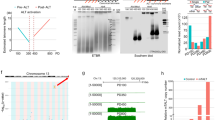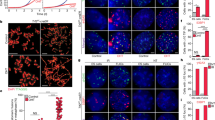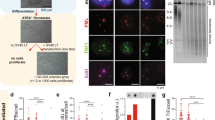Abstract
The ribonucleoprotein enzyme telomerase synthesizes telomeric DNA onto chromosome ends1. Telomere length is maintained, by the presence of telomerase activity, in the vast majority of primary tumours and stem cells2,3, suggesting that telomere maintenance is essential for cellular immortalization. Recently, the telomerase RNA component in human4 and mouse5 (TERC and Terc, respectively), a telomerase-associated protein TEP1/TLP1 (refs 6,7) and the human catalytic subunit protein TERT (Refs 8,9) have been identified. To examine the role of telomerase in telomere maintenance and cellular viability, we established Terc-deficient embryonic stem (ES) cells. It is known that telomerase activity is absent in cells from Terc-knockout mice10. Although the study showed that telomere shortening was observed in the Terc-deficient cells from first to six generation animals, whether telomerase-dependent telomere maintenance was essential for cellular viability remained to be elucidated. To address this issue, we examined Terc-deficient ES cells under long-term culture conditions. Accompanying the continual telomere shortening, the growth rate of Terc-deficient ES cells was gradually reduced after more than 300 divisions. An impaired growth rate was maintained to approximately 450 divisions, and then cell growth virtually stopped. These data clearly show that telomerase-dependent telomere maintenance is critical for the growth of mammalian cells.
This is a preview of subscription content, access via your institution
Access options
Subscribe to this journal
Receive 12 print issues and online access
$209.00 per year
only $17.42 per issue
Buy this article
- Purchase on Springer Link
- Instant access to full article PDF
Prices may be subject to local taxes which are calculated during checkout




Similar content being viewed by others
References
Greider, C.W. Telomere length regulation. Annu. Rev. Biochem. 65, 337–365 (1996)
Harley, C.B. et al. Telomerase, cell immortality, and cancer. Cold Spring Harbor Symp. Quant. Biol. 59, 307–315 (1994)
Kim, N.W. et al. Specific association of human telomerase activity with immortal cells and cancer. Science 266, 2011–2015 (1994)
Feng, J. et al. The RNA component of human telomerase. Science 269, 1236–1241 (1995)
Blasco, M.A. Funk, W. Villeponteau, B. Greider, C.W. Functional characterization and developmental regulation of mouse telomerase RNA. Science 269, 1267–1270 (1995)
Harrington, L. et al. A mammalian telomerase-associated protein. Science 275, 973–977 (1997)
Nakayama, J.-I. Saito, M. Nakayama, H. Matsuura, A. Ishikawa, F. TLP1: a gene encoding a protein component of mammalian telomerase is a novel member of WD repeats family. Cell 88, 875–884 (1997)
Nakayama, T.M. et al. Telomerase catalytic subunit homologs from fission yeast and human. Science 277, 955–959 ( 1997)
Meyerson, M. et al. hEST2, the putative human telomerase catalytic subunit gene, is up-regulated in tumor cells and during immortalization. Cell 90, 785–795 (1997)
Blasco, M.A. et al. Telomere shortening and tumor formation by mouse cells lacking telomerase RNA. Cell 91, 25–34 (1997)
Kipling, D. Cooke, H.J. Hypervariable ultra-long telomeres in mice. Nature 347, 400–402 (1990)
Zijlmans, J.M.J.M. et al. Telomerase in the mouse have large inter-chromosomal variations in the number of T2AG3 repeats. Proc. Natl. Acad. Sci. USA 94, 7423–7428 (1997)
Prowse, K.R. Greider, C.W. Developmental and tissue-specific regulation of mouse telomerase and telomere length. Proc. Natl. Acad. Sci. USA 92, 4818–4822 ( 1995)
Singer, M.S. Gottschling, D.E. TLC1: template RNA component of Saccharomyces cerevisiae telomerase. Science 266, 404–409 (1994)
Lundblad, V. Szostak, J.W. A mutant with a defect in telomere elongation leads to senescence in yeast. Cell 57, 633 –643 (1989)
Lundblad, V. Blackburn, E.H. An alternative pathway for yeast telomere maintenance rescues est1-senescence. Cell 73, 347–360 (1993)
McEachern, M.J. Blackburn, E.H. Cap-prevented recombination between terminal telomeric repeat arrays (telomere CPR) maintains telomeres in Kluyveromyces lactis lacking telomerase. Genes Dev. 10, 1822–1834 (1996)
Bryan, T.M. Englezou, A. Gupta, J. Bacchetti, S. Reddel, R.R. Telomere elongation in immortal human cells without detectable telomerase activity. EMBO J. 14, 4240–4248 (1995)
Bryan, T.M. Engezou, A. Dalla-Pozza, L. Dunham, M.A. Reddel, R.R. Evidence for an alternative mechanism for maintaining telomere length in human tumors and tumor-derived cell lines. Nature Med. 3, 1271–1274 ( 1997)
Weinrich, S.L. et al. Reconstitution of human telomerase with the template RNA component hTR and the catalytic protein subunit hTRT. Nature Genet. 17 , 498–502 (1997)
Bodnar, A.G. et al. Extension of life-span by introduction of telomerase into normal human cells . Science 279, 349–352 (1998)
Gorman, J.R. et al. The Igk 3´ enhancer influences the ratio of Igk versus Igl B lymphocytes . Immunity 5, 241–252 (1996)
Mansour, S.L. Thomas, K.R. Capecchi, M.R. Disruption of the proto-oncogene int-2 in mouse embryo-derived stem cells: a general strategy for targeting mutations to non-selectable genes. Nature 336, 348–352 ( 1988)
Kanegae, Y. et al. Efficient gene activation in mammalian cells by using recombinant adenovirus expressing site-specific Cre recombinase. Nucleic Acids Res. 23, 3816–3821 (1995)
Miller, S.A. Dykes, D.D. Polesky, H.F. A simple salting out procedure for extracting DNA from human nucleated cells . Nucleic Acids Res. 16, 1215 (1988)
Radic, M.Z. Lundgren, K. Hamkalo, B.A. Curvature of mouse satellite DNA and condensation of heterochromatin. Cell 50, 1101–1108 ( 1987)
Lee, H.-W. et al. Essential role of mouse telomerase in highly proliferative organs. Nature 392, 569–574 ( 1998)
Acknowledgements
We thank I. Saito for providing the recombinant Cre adenovirus, R. Narayanan for helpful discussions and comments and M. Shio for FISH analysis.
Author information
Authors and Affiliations
Rights and permissions
About this article
Cite this article
Niida, H., Matsumoto, T., Satoh, H. et al. Severe growth defect in mouse cells lacking the telomerase RNA component . Nat Genet 19, 203–206 (1998). https://doi.org/10.1038/580
Received:
Accepted:
Issue Date:
DOI: https://doi.org/10.1038/580
This article is cited by
-
Epigenetic regulation of BAF60A determines efficiency of miniature swine iPSC generation
Scientific Reports (2022)
-
Do long telomeres affect cellular fitness?
Current Genetics (2018)
-
Telomere length and iPSC re-programming: survival of the longest
Cell Research (2012)
-
Inhibition of poly (ADP-Ribose) polymerase-1 in telomerase deficient mouse embryonic fibroblasts increases arsenite-induced genome instability
Genome Integrity (2010)



